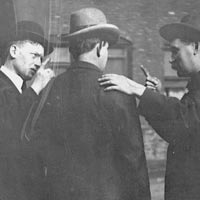Andrew Bruce was born April 15th, 1866 in Nunda Drug, India. Although he would later reside in the United States, he was English by birth. Andrew’s father Edward Archibald Bruce, was a General in the British Army and stationed in India at the time of Andrew’s birth. Andrew first came to the United States at age 15, and would stay there for his education. As a young adult he enrolled in the University of Wisconsin and graduated in 1890 at the age of 24. After graduation he decided to pursue a career in law, and enrolled in the University of Wisconsin Law School.
He graduated from Wisconsin’s Law School in 1892 and received a job working as a secretary to the Wisconsin Supreme Court Justices. After only a year working as a secretary to the court, Bruce moved to Chicago to practice as an attorney. His first five years in Chicago were spent working for the state board of factory inspectors. It was during his work as an attorney in Chicago that Bruce fought in favor of workers’ rights in the Ritchie v. People case in 1895. Throughout Bruce’s career, he was an avid advocate of labor laws, specifically child labor, and Bruce helped establish sweat shop laws in Illinois and Wisconsin.
After his work for the board of factory inspection Bruce returned to Wisconsin in 1898 to work as Assistant Professor of Law at the University from which he had received his law degree just six years prior, and by 1902 he had become Full Professor. After serving some time as a Professor of Law at Wisconsin, Bruce decided to take on a more administrative role, and became the Dean of the College of Law at the University of North Dakota.
In 1911, he began to practice his legal expertise in a new manner altogether, and became an Assistant Judge to the North Dakota Supreme Court, and by 1916 he attained the position of Chief Justice. After three years, however, Bruce returned to academia and accepted a professorship at the University of Minnesota School of Law in 1919. Bruce returned to Chicago in 1922 and accepted a Professorship at Northwestern University School of Law; he would retain this position until his death.
In addition to his professional career as a practicing attorney, Professor of Law, and judge, Bruce used his legal expertise in other ways. He wrote several books on law, and frequently contributed to legal magazines, articles, and newspapers. He also served as a “Minute Man” during the First World War. In 1919, Bruce was appointed by the American Bar Association as a member of a committee which investigated the procedures of military courts-martial.
Bruce further applied his legal experience to the national arena serving as President of the American Institute of Criminal Law and Criminology. He was chairman of the Illinois Adjustment board for the National Recovery Act; later in October of 1933 he was appointed to the compliance board overseeing the National Recovery Act, and after a month, President Roosevelt appointed him as chairman to this board as well. That same month, Bruce became sick with a bronchial illness, from which he never fully recovered. On Dec. 6, 1934 after a week of particularly poor health, Andrew Bruce died at the age of 68.
Next: John W. Ela
